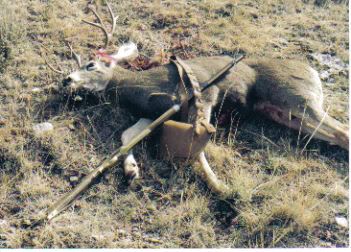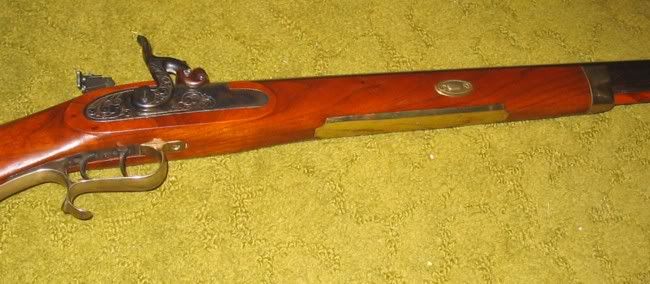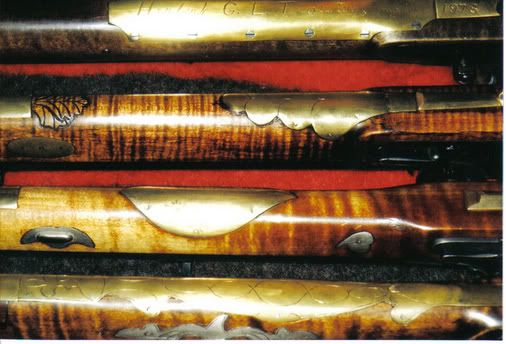A while back I saw a Hawken that had a metal plate on the bottom of the forestock. I thought that this was a repair, that someone knocked the bottom hard and broke out the thin area between the bottom and the ramrod hole. I recently saw some photos of other rifles with more elaborate plates, called belly plates. Were these originally put on a rifle? Were they to strengthen the area or just for looks?
-
Friends, our 2nd Amendment rights are always under attack and the NRA has been a constant for decades in helping fight that fight.
We have partnered with the NRA to offer you a discount on membership and Muzzleloading Forum gets a small percentage too of each membership, so you are supporting both the NRA and us.
Use this link to sign up please; https://membership.nra.org/recruiters/join/XR045103
You are using an out of date browser. It may not display this or other websites correctly.
You should upgrade or use an alternative browser.
You should upgrade or use an alternative browser.
Belly Plates
- Thread starter crockett
- Start date

Help Support Muzzleloading Forum:
This site may earn a commission from merchant affiliate
links, including eBay, Amazon, and others.
They were generally put on if a ramrod drilling went astray, or if the forend had worn through. I made one like that many years ago. About twenty years back, there were a couple makers in this area that put out quite a few rifles with wear plates for cosmetic purposes. They do look kind of neat. The only real drawback is if you hunt in cold weather. They do chill the fingers pretty well when you carry them all day.
Some of them were known as pommel plates.
When on horseback, the rider often rested his rifle on the pommel of the saddle in front of the rider.
The metal plate kept the wood stock from being worn.
At least, that's what the gunsmith that drilled the ramrod hole thru the forearm said. ::
When on horseback, the rider often rested his rifle on the pommel of the saddle in front of the rider.
The metal plate kept the wood stock from being worn.
At least, that's what the gunsmith that drilled the ramrod hole thru the forearm said. ::
Herb
54 Cal.
- Joined
- Mar 19, 2004
- Messages
- 1,954
- Reaction score
- 456
Crockett, some rifles were made with them and some were added later as repairs.

This is my Green River Leman Trade Rifle which I made at the Green River Rifle Works in 1978 in a class called "Antique Custom Riflesmithing". The instructor, Greg Roberts, drilled my ramrod hole and the bit came out the bottom of the stock. That's why I fitted this wear plate. Some gunmakers, including in Western Pennsylvania, fitted them to rifles they made. There is a Jacob Wigle rifle in a museum here, made in Westmoreland County, PA between 1811 and 1844, that has a wear plate original to it.
Some Bedford rifles were made with wear plates.

This is my Green River Leman Trade Rifle which I made at the Green River Rifle Works in 1978 in a class called "Antique Custom Riflesmithing". The instructor, Greg Roberts, drilled my ramrod hole and the bit came out the bottom of the stock. That's why I fitted this wear plate. Some gunmakers, including in Western Pennsylvania, fitted them to rifles they made. There is a Jacob Wigle rifle in a museum here, made in Westmoreland County, PA between 1811 and 1844, that has a wear plate original to it.
Some Bedford rifles were made with wear plates.
Personally, I like the brass panal on some half stocks.
This is the .54 TC Hawken I built years ago.
The little extra touches I added were a toe plate, one of the oval brass plates with the machine engraged Eagle on the cheekpiece a thumb plate and this pommel plate.

This is the .54 TC Hawken I built years ago.
The little extra touches I added were a toe plate, one of the oval brass plates with the machine engraged Eagle on the cheekpiece a thumb plate and this pommel plate.

Herb
54 Cal.
- Joined
- Mar 19, 2004
- Messages
- 1,954
- Reaction score
- 456

Similar threads
- Replies
- 7
- Views
- 454
- Replies
- 0
- Views
- 203
- Replies
- 13
- Views
- 844




